What Is Mobile Advertising?
Mobile advertising is a marketing method that involves displaying paid promotional messages on mobile devices like smartphones and tablets. And aims to have users convert (take a desired action) in response to the promotional material.
Such as by:
- Purchasing a product
- Signing up for a webinar
- Subscribing to an email list
Mobile ads come in many forms that we’ll go over later. And in addition to text, they can also include images, animations, or video.
Mobile Marketing vs. Mobile Advertising
Mobile marketing aims to connect with and convert target audiences who use mobile devices through a variety of tactics. Which can include social media marketing, mobile SEO, paid mobile ads, and more.
Mobile advertising is a subset of mobile marketing.
But it focuses only on running paid ads that are shown on mobile devices.
The Advantages of Mobile Advertising
By running mobile ads, you can see a number of benefits:
Create More User Touch Points
Advertising on mobile can be part of a broader omnichannel marketing strategy where you market to users across various devices and channels. To help nurture users through your marketing funnel and drive them toward conversion.
Let’s say your company is ConvertKit and you’re running mobile ads on Instagram to promote your email platform. On the ConvertKit website, you can install a tracking code known as a “pixel” to track visitors to the site.
You can then create a remarketing campaign that displays your Instagram and ads to ConvertKit website visitors.
So, when a user browses the ConvertKit website on one device—like their desktop computer—the pixel you’ve added logs their activity and keeps track of them.
This means that when the user opens the Instagram app on their phone later, they may see an Instagram ad promoting ConvertKit:
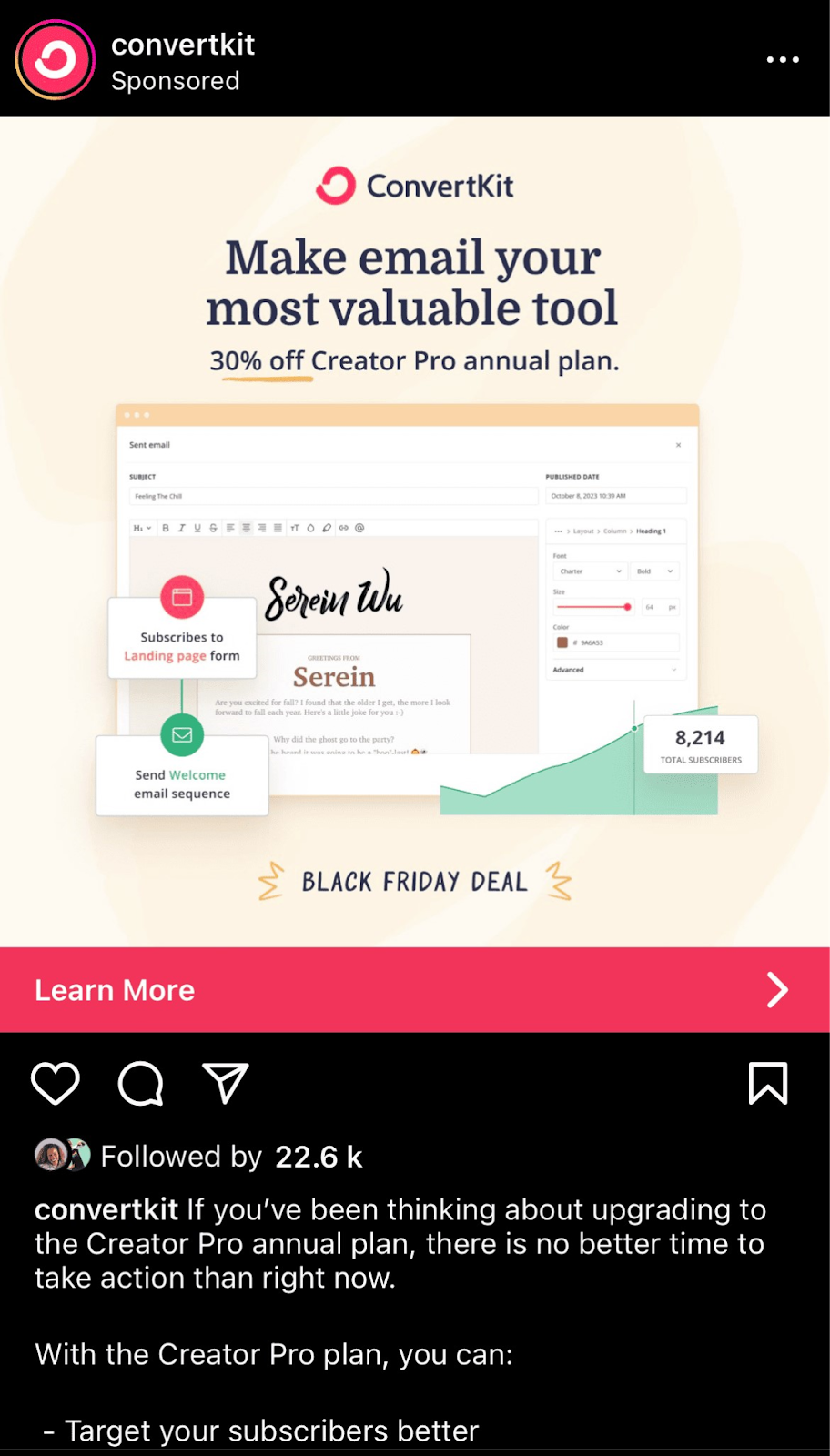
The ad reminds them of their interest in the platform. Which could prompt them to return to the ConvertKit website and explore it further. And perhaps even register for an account.
Reach Your Audience While They’re on the Go
The portability of mobile devices lets you reach your audience even if they’re not logged in to their computers.
Bear in mind that they’ll likely be pulling out their mobile devices to:
- Chat with family and friends
- Scroll through their favorite social media platforms
- Play mobile games
In fact, Americans aged 18 and older spend four hours and 25 minutes on their mobile phones each day, according to a survey from Reviews.org.
This gives you a significant opportunity to engage them via mobile advertising.
It also doesn’t matter where your audience is. They could be at a coffee shop hanging out with friends. They could be on the bus traveling to the airport. They could even be hiking in the forest.
As long as they have their mobile device and an internet connection, your mobile ads can reach them.
Target Your Audience More Precisely
Mobile devices can provide data on their users’ locations.
This lets you engage in “geotargeting.” In other words, run targeted only users in certain areas while they’re in those areas.
Running ads like these helps you optimize your ad budget if your ads are relevant to only certain geographical segments.
For example, if you run an aesthetician center in New York City, you could choose to run search ads through Google Ads promoting your facials to only users whose current location falls within a radius around a particular location within New York City.
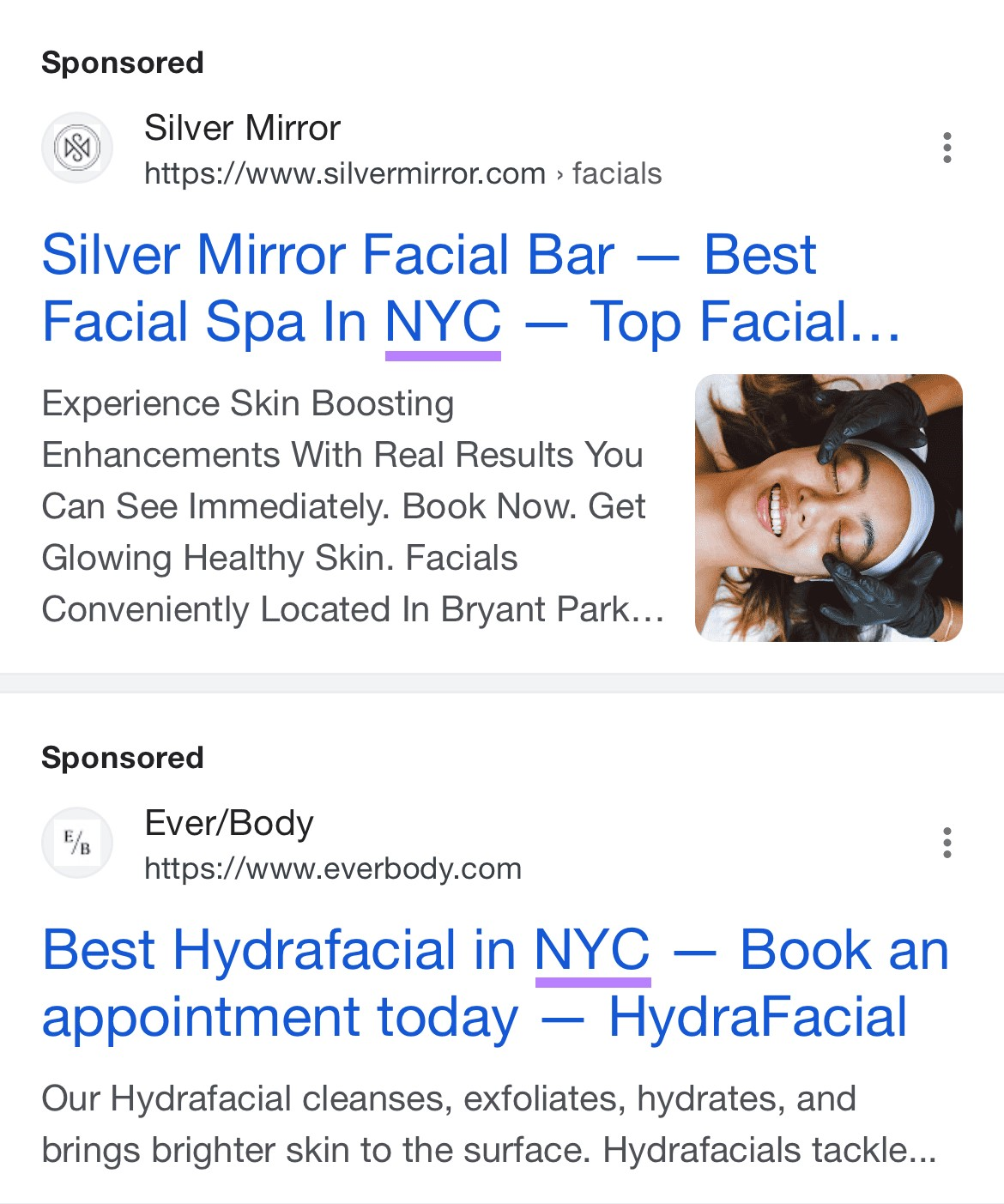
Yes, these ads will reach people using desktop devices within that area. But the real benefit is that they’ll also reach people using mobile devices who might only be in that location for a short amount of time.
So, when these mobile users start Googling for places to get a facial, they could see your ad. And if they find your aesthetician center’s location convenient, they might make an appointment.
There’s little point in advertising to mobile users in other locations. Because they probably won’t make the trip to visit your center.
As a result, you’d likely waste money showing your ads to people who are unlikely to convert.
Types of Mobile Advertising
Here are five common types of mobile ads and mobile advertising examples for each of them:
1. Mobile Banner Ads
Mobile banner ads are mobile ads displayed on webpages.
They often appear as horizontal rectangles—similar to the physical banners you might see outdoors. But they can also be shaped as squares or vertical rectangles.
Mobile banner ads can be located:
- At the top of the page
- At the bottom of the page
- In the middle of the page’s content
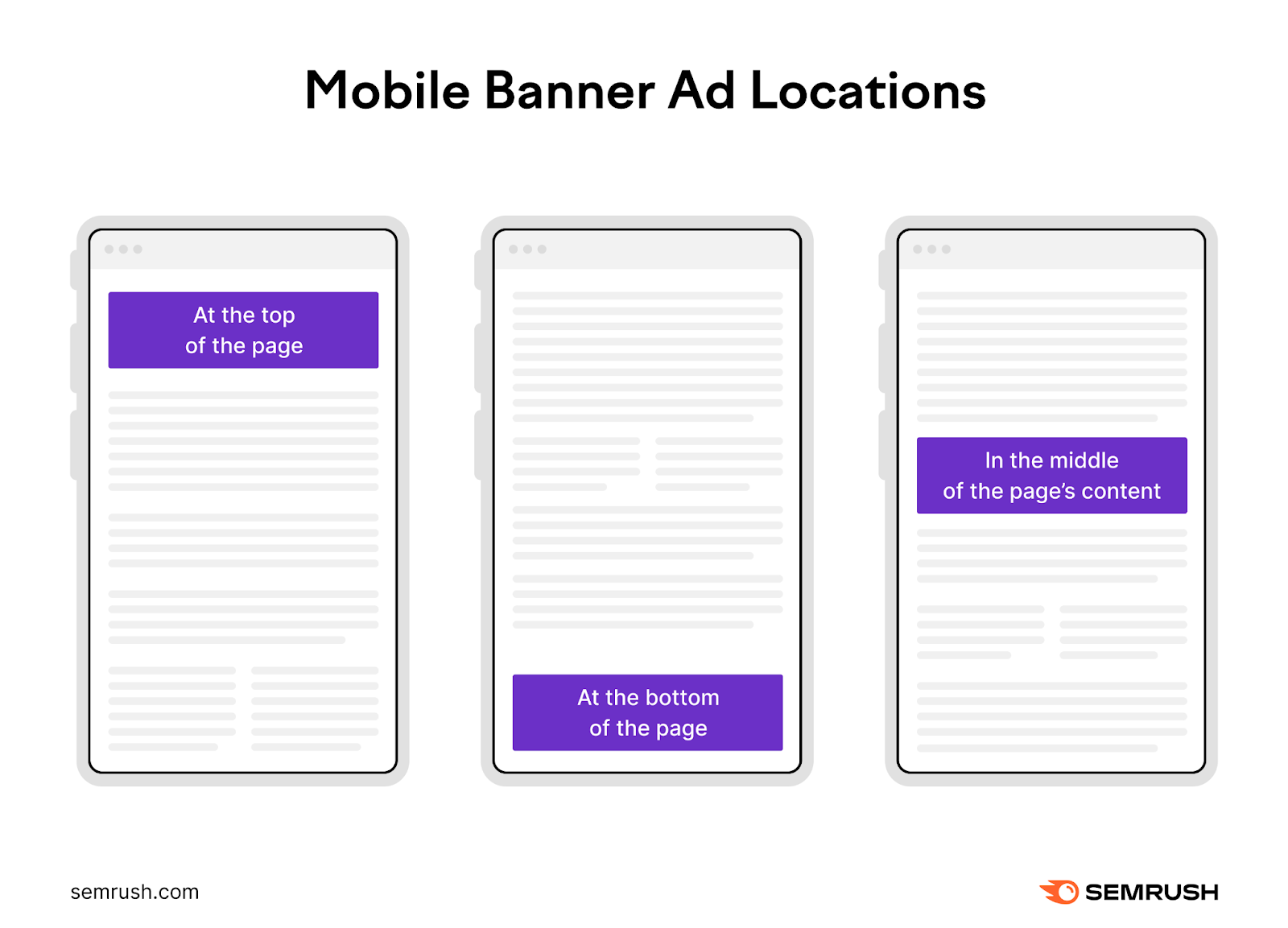
For example, PCMag displays mobile banner ads throughout its sleep tech guide. Including this one:
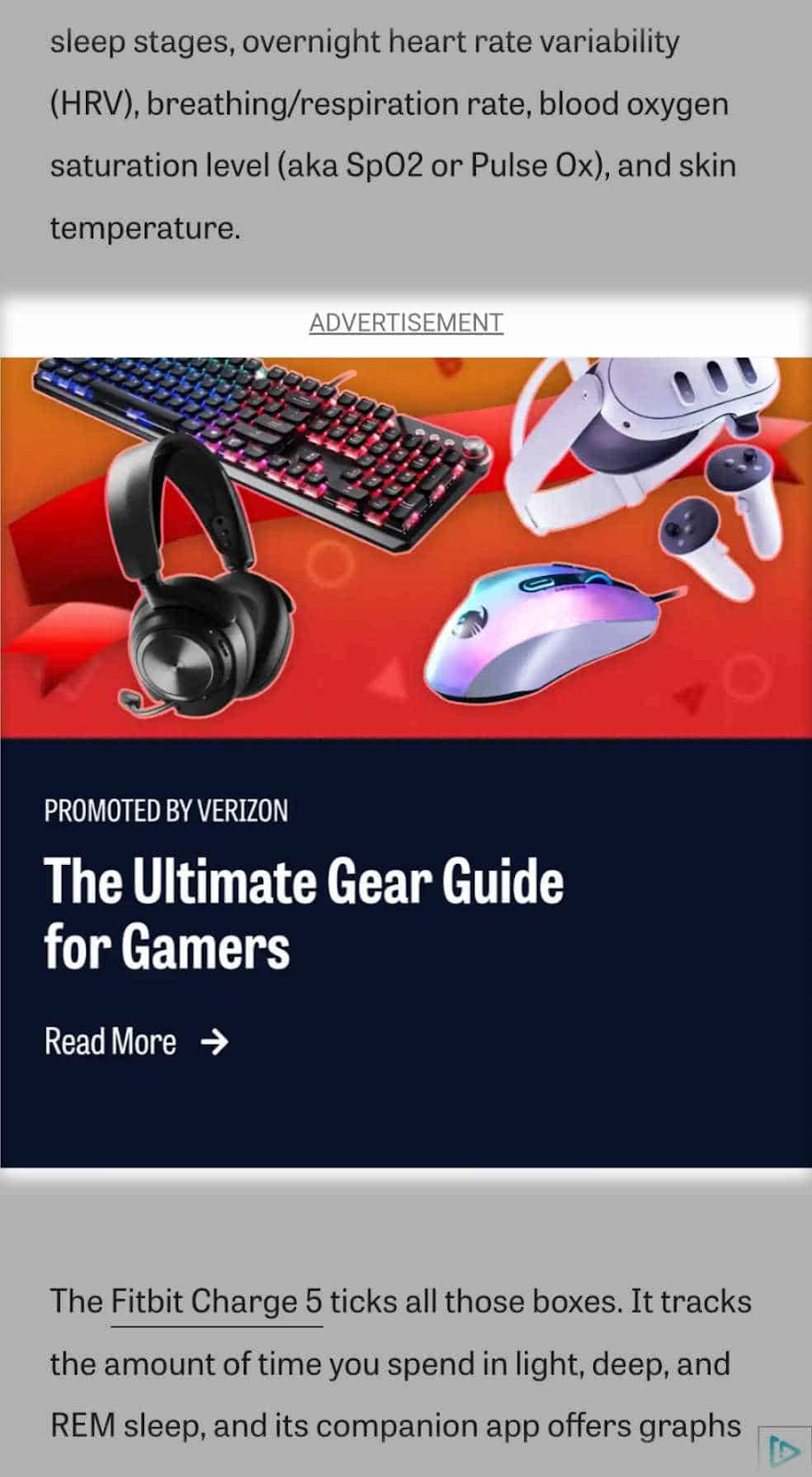
Mobile banner advertisements placed at the top or bottom of the page can also be “sticky.” Meaning they remain in view even as the user scrolls.
Take a look at this Best Buy product page for noise-canceling headphones. Which has two mobile banner ads at the top of the page:
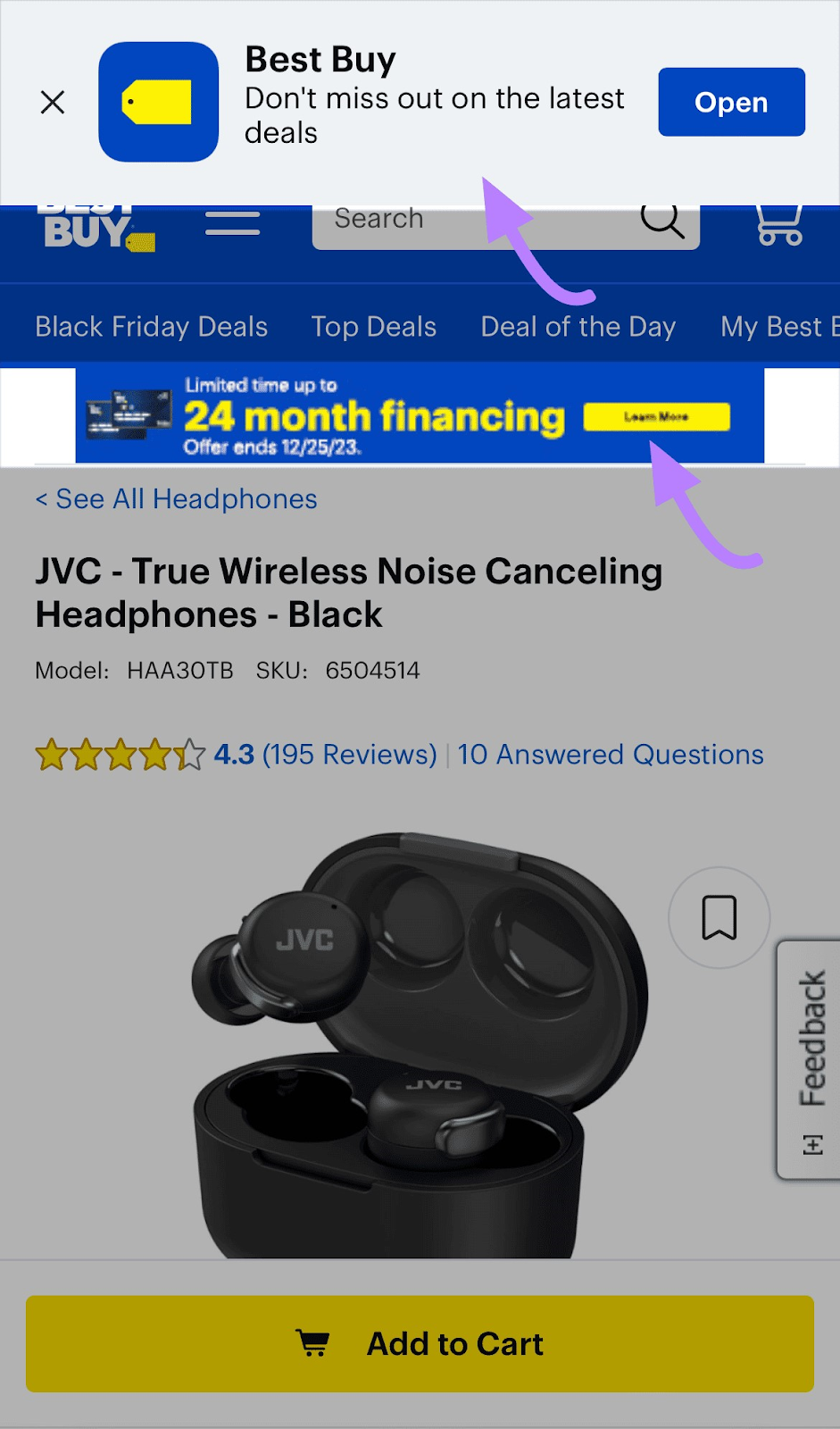
The “Don’t miss out” ad is sticky. While the “Limited time” ad isn’t.
Mobile banner ads come in various sizes optimized for viewing on mobile screens. Standard sizes include:
- 300 x 50 pixels
- 320 x 50 pixels
- 320 x 90 pixels
2. Interstitial Ads
Interstitial ads are mobile ads that take up the full screen on mobile devices.
They often appear while users interact with content on the screen. And require users to wait and then close them before they can continue with the interaction.
For example, when you try to play The New York Times’s Wordle game on your mobile phone, you may first see an interstitial ad. Which you have to close by clicking “Continue to Wordle” before you can proceed to the game.
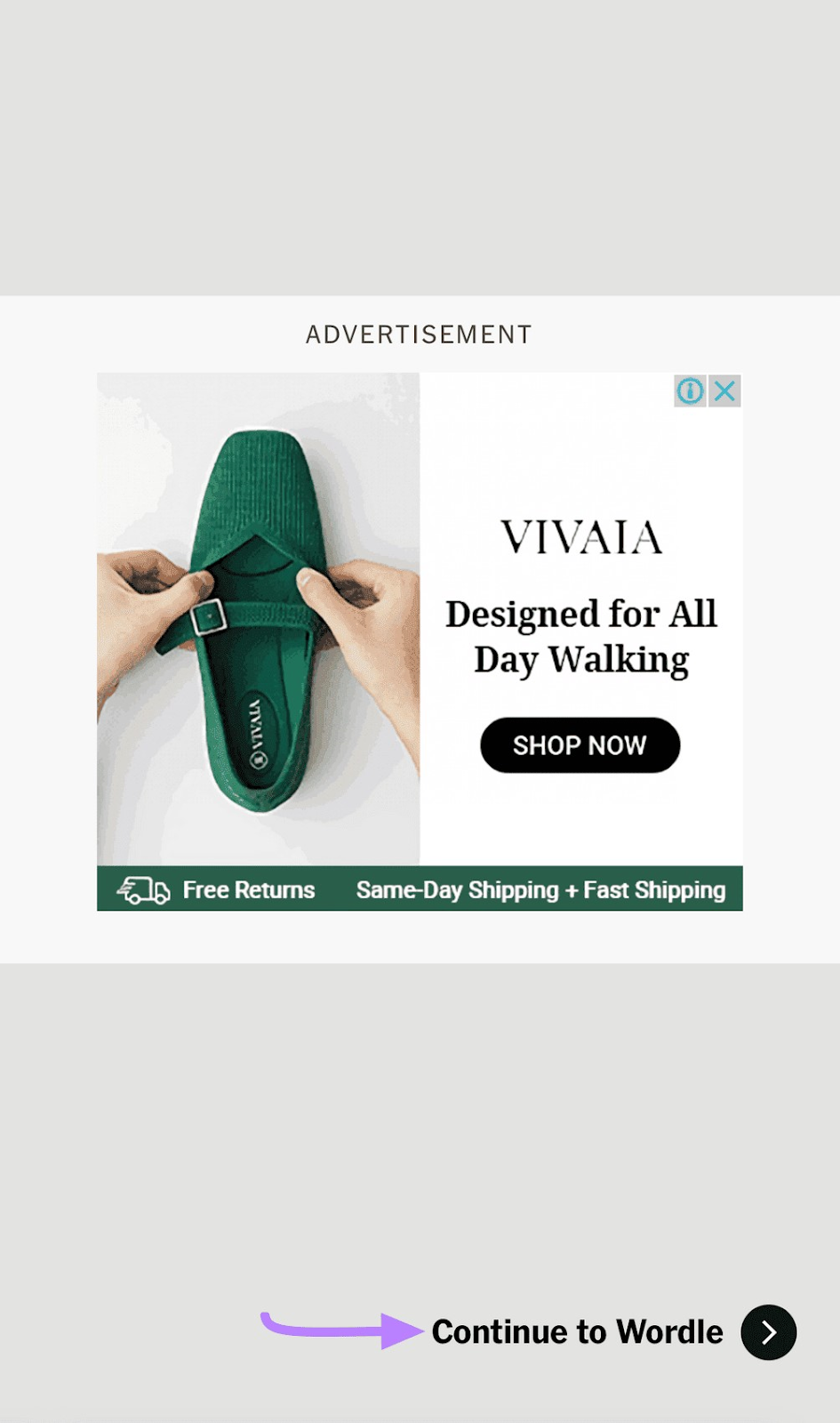
Users may be more likely to engage more with interstitial ads than mobile banner ads.
Why?
Because the full-screen nature of interstitial ads prevents users from seeing—or doing—anything else on the screen while the ad is there.
Users also have to take action to close the ad if they aren’t interested in it.
Since interstitial ads can be more effective than mobile banner ads, advertisers are often willing to pay more for them.
The average effective cost per mille (eCPM) for interstitial ads—meaning, the amount that advertisers pay for every 1,000 impressions of their ad—can be as much as 4,094% higher than for banner ads, according to a study by Adnimation.
But displaying interstitial ads can hurt the user experience on your pages. Because they hinder users from accessing the content they want to see.
Especially annoyed users may even avoid visiting your website in the future.
Google may also rank pages that offer a poor page experience lower on the search engine results pages (SERPs). Their guidelines on interstitials recommend website owners display mobile banner ads on their pages instead of interstitial ads.
3. Push Notification Ads
Push notification ads appear as short alert messages on a user’s mobile device. Businesses often send (or “push”) these cellphone advertisements to their app users when they have a timely promotional message to share.
Here’s an example of a push notification ad from the ShopBack mobile app:
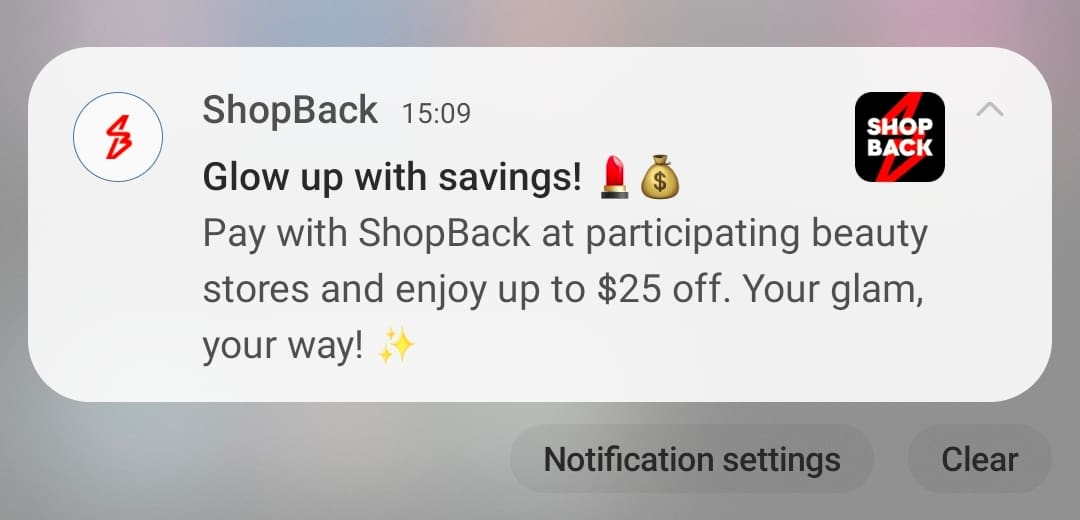
While users can receive push notification ads from websites, they more commonly get them from their mobile devices’ apps.
The user also doesn’t need the relevant website or app open on their device to receive push notifications. But the user needs to consent to receiving push notification ads first.
Only Natural Pet gains consent by displaying a website pop-up asking users if they want to receive the business’s notifications:
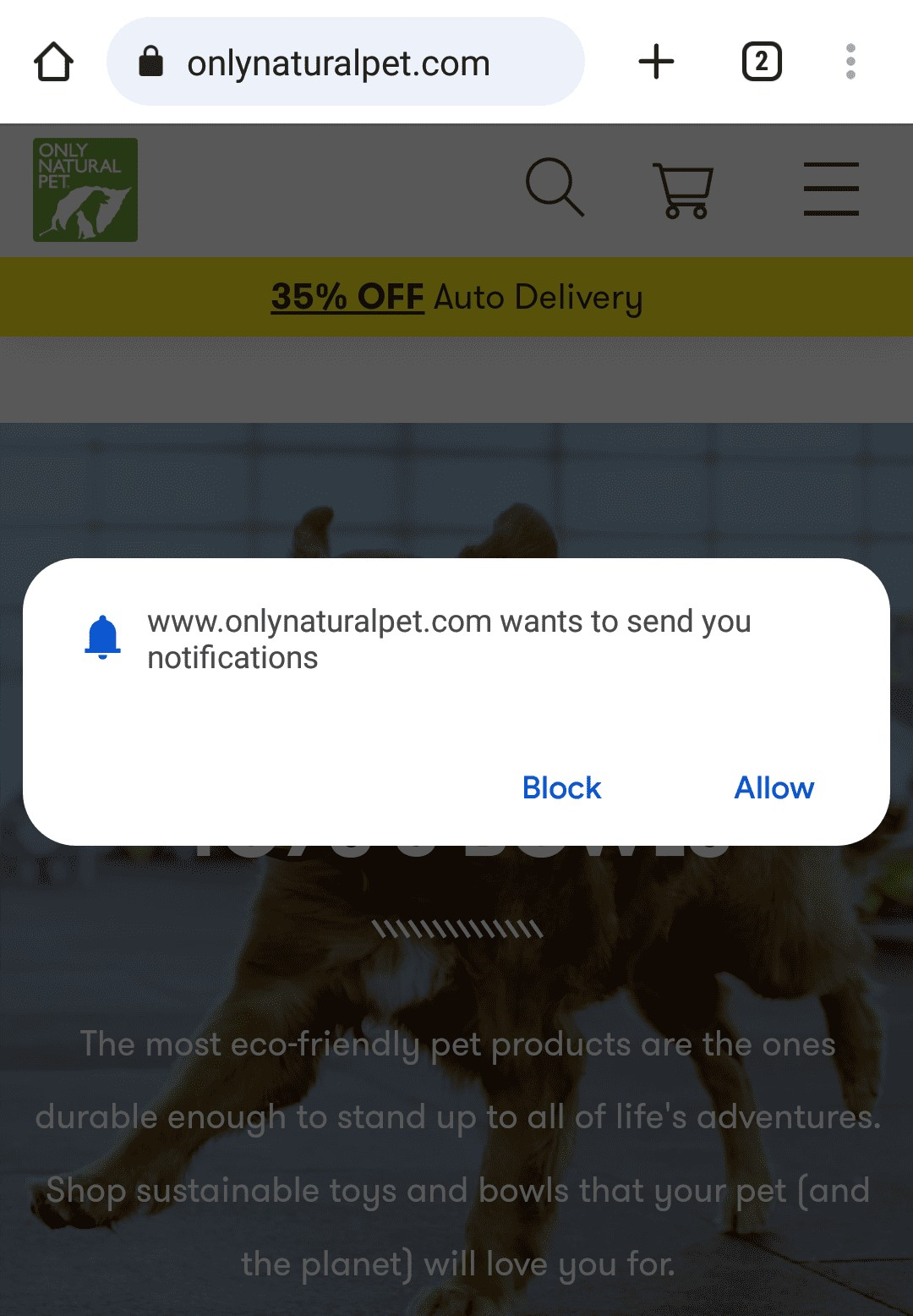
And the Amazon app contains settings users can turn on or off to receive push notifications about savings, product recommendations, and new releases.
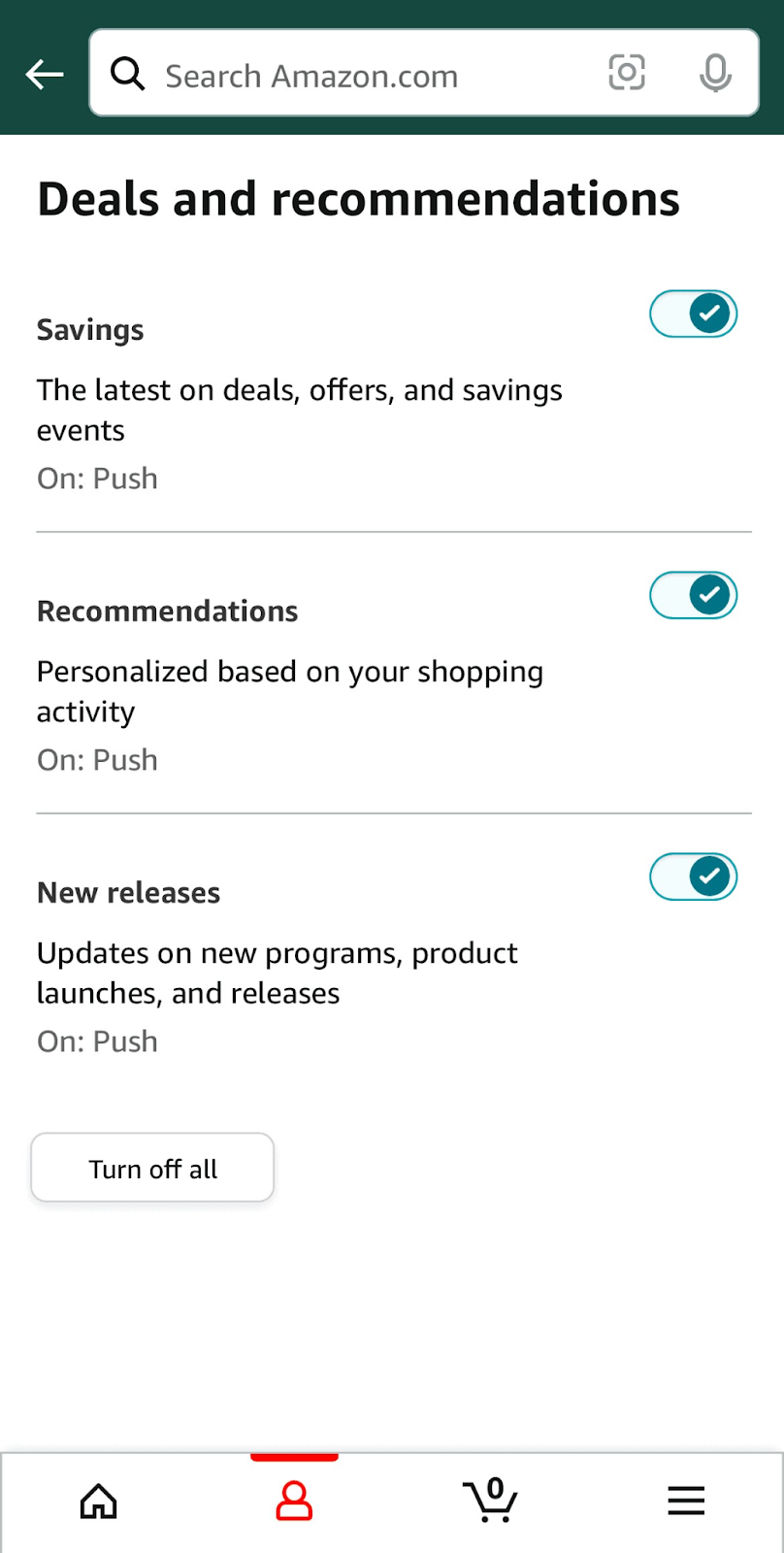
Users can opt out of receiving push ads anytime. Preventing you from marketing to them in that way.
4. Social Media Ads
Social media ads appear as users browse content on social media platforms.
For example, here’s an Instagram Story ad for Adobe:
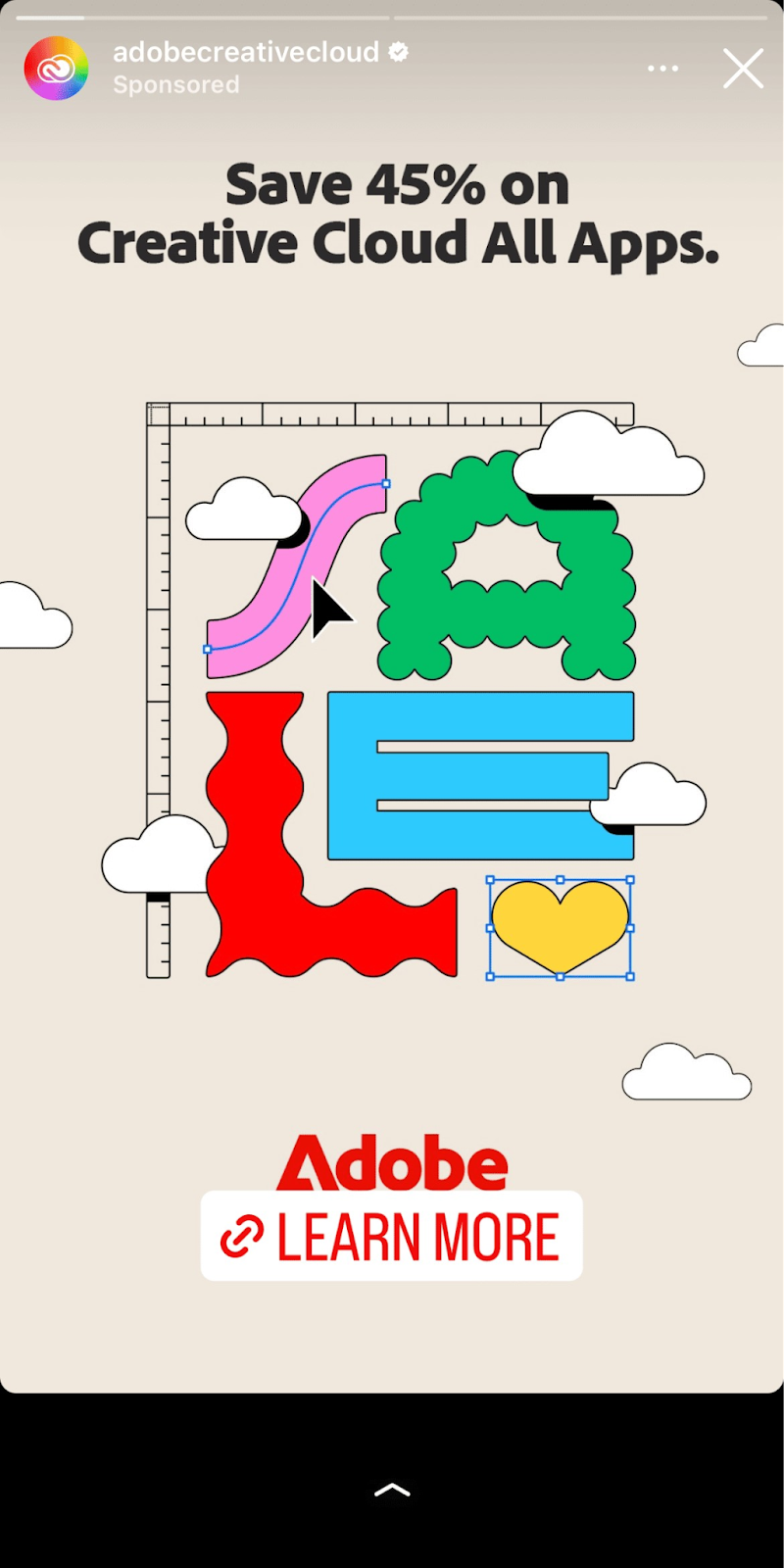
Here’s a Facebook feed ad for Stripe:
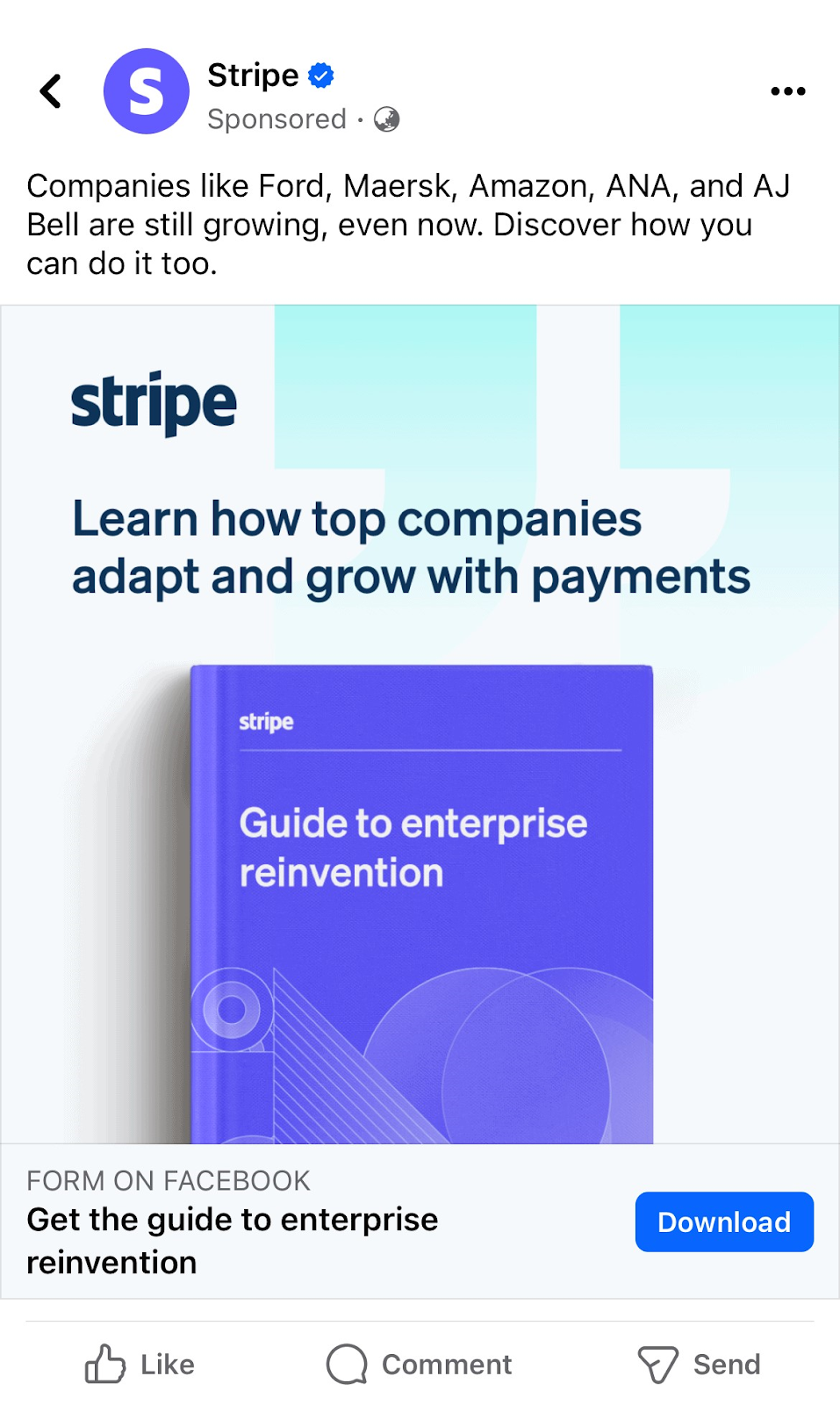
And here’s a TikTok video ad for H&M.
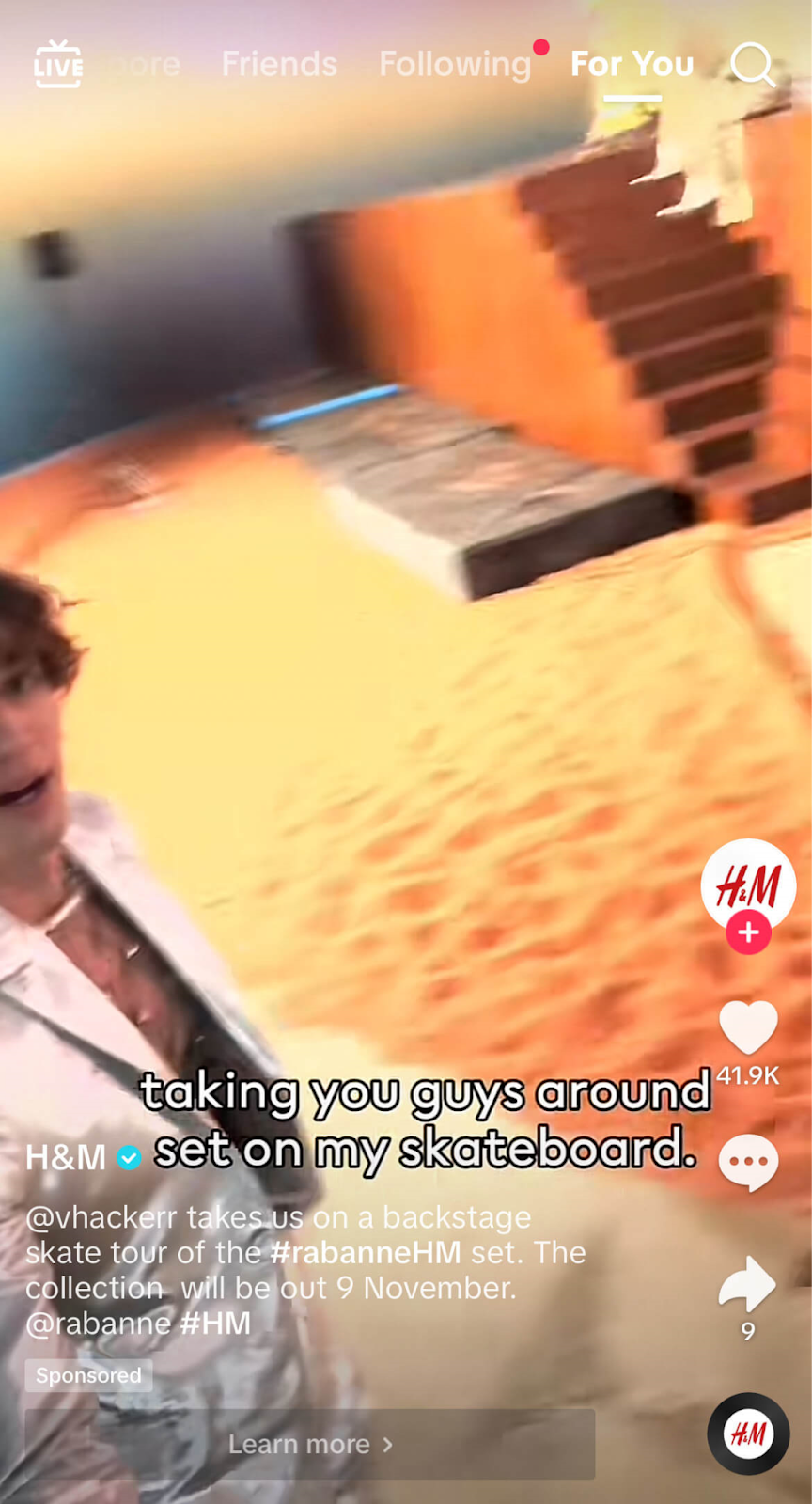
Each of these mobile advertising examples has a different format.
Adobe’s Instagram Story ad is a static full-screen image. Stripe’s Facebook feed ad is an image post. And H&M’s TikTok ad is a full-screen video.
The brands have formatted their ads to match the relevant social media platform’s ad format requirements and recommendations. And you’ll need to do the same for your social media ads.
For example, if you are placing an Instagram Story video ad, your ad should fulfill requirements like having a 9:16 aspect ratio. And being no longer than 60 seconds.
If you intend to display an image ad on users’ Facebook feeds, Meta’s recommendations for your ad include:
- Adding an image of at least 1,080 x 1,080 pixels in size
- Writing a headline and description of up to 27 characters each
- Providing primary text of up to 125 characters
Social ads can be effective, too.
An impressive 34% of consumers say that social media ads influence their pre-purchase decisions, according to a June 2023 PwC consumer survey.
5. In-App Advertisements
In-app advertisements appear within mobile apps.
They can come in forms like the following:
- Classic banner ad: A rectangular banner ad at the top or the bottom of the app screen
- Medium rectangle: A rectangular ad that’s taller than a classic banner ad. It’s placed in the middle of the app content.
- Interstitial: A full-screen ad on the app screen that users need to manually close. Interstitial ads were the most-encountered type of in-app ad for 39.1% of app users and marketers surveyed by GoodFirms in 2023.
- Native advertising: An ad that takes on the appearance and format of the content surrounding it. So it looks like part of the content itself.
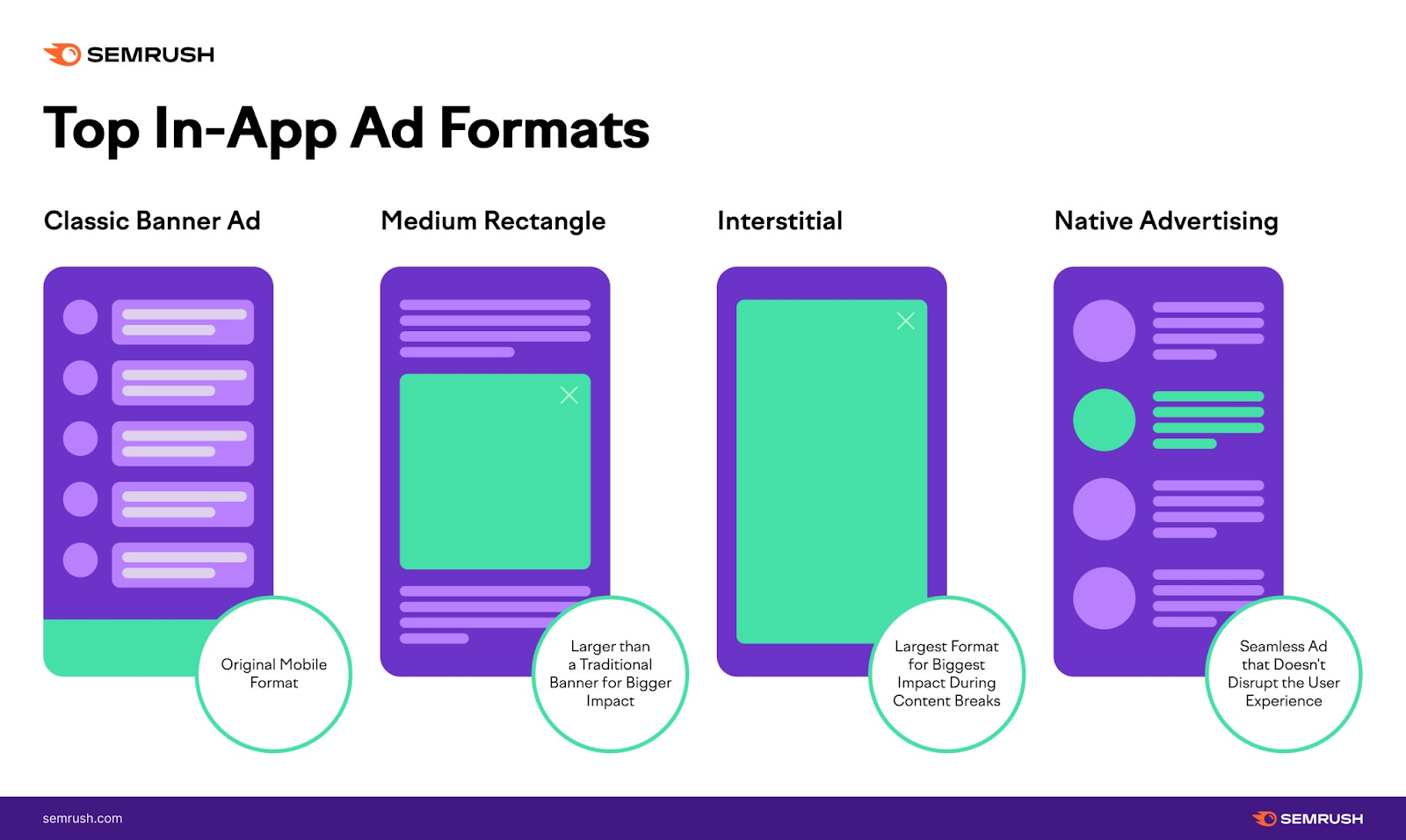
For instance, this native ad in the Todoist mobile app encourages users to upgrade to a Todoist Pro plan.
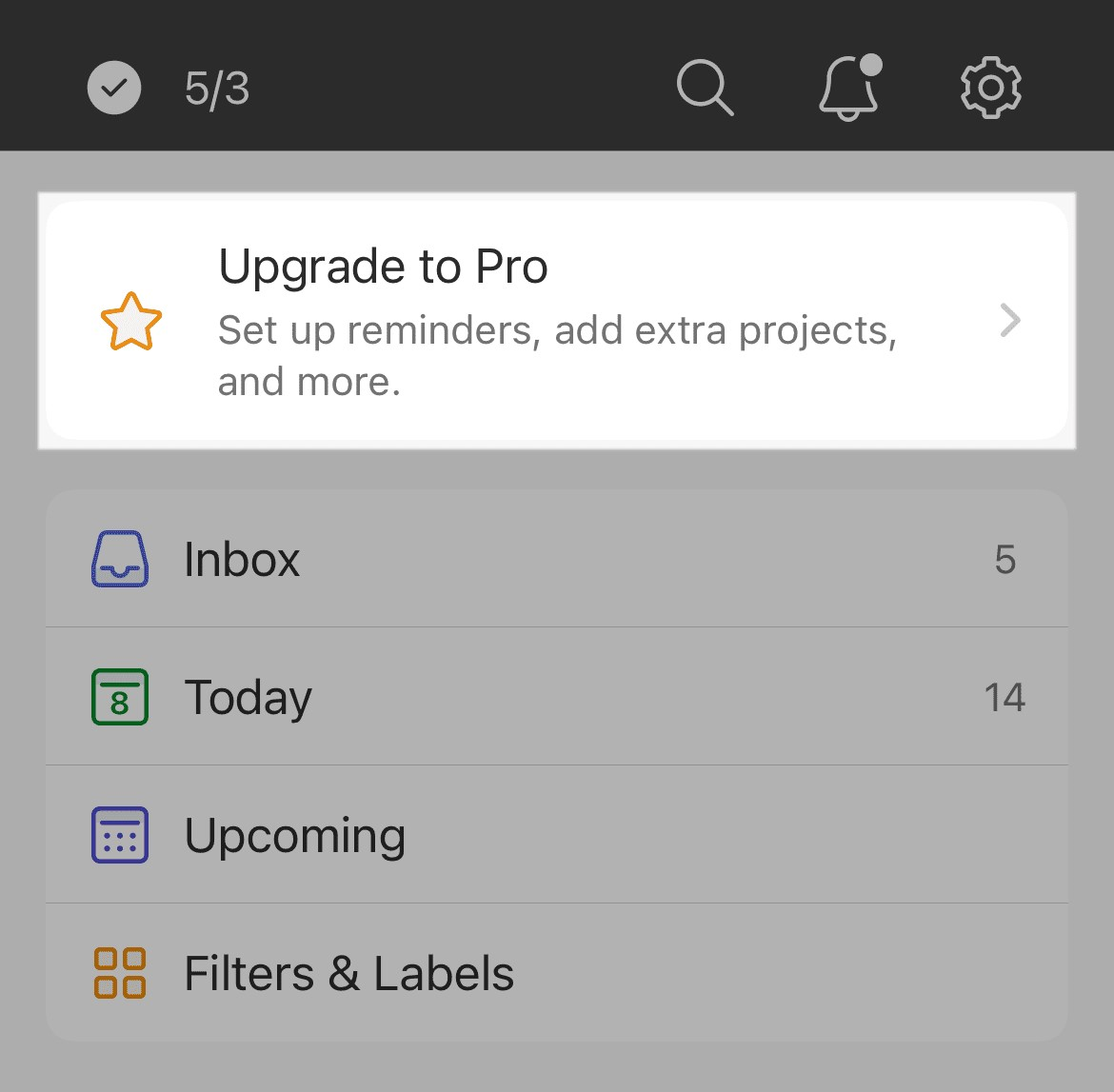
Further reading: Mobile App Marketing 101: How to Reach Your Audience
What’s the Cost of Mobile Advertising?
The average eCPM for interstitial mobile ads on iOS devices in the U.S. was $13.61 in the fourth quarter of 2023, reports Appodeal.
According to the same Appodeal report, here’s the average eCPM for displaying other formats to U.S. users across a few device types:
- Interstitial ads on Android: $13.23
- Banner ads on iOS: $0.31
- Banner ads on Android: $0.43
Tips for Creating a Successful Mobile Advertising Strategy
These best practices can help you get the most out of a limited mobile digital advertising budget:
Use Keywords That Are Suitable for Mobile Ads
If you’re running search ads or banner ads that rely on keywords, make sure the keywords you’re considering are a good fit for mobile. To increase the likelihood your ads will show and drive relevant traffic to your site.
Semrush’s Keyword Overview tool can help you with this.
Launch the tool and type a keyword you’re thinking of using for your ads.
Select the country and a location within that country if you wish. Then, click “Search.”
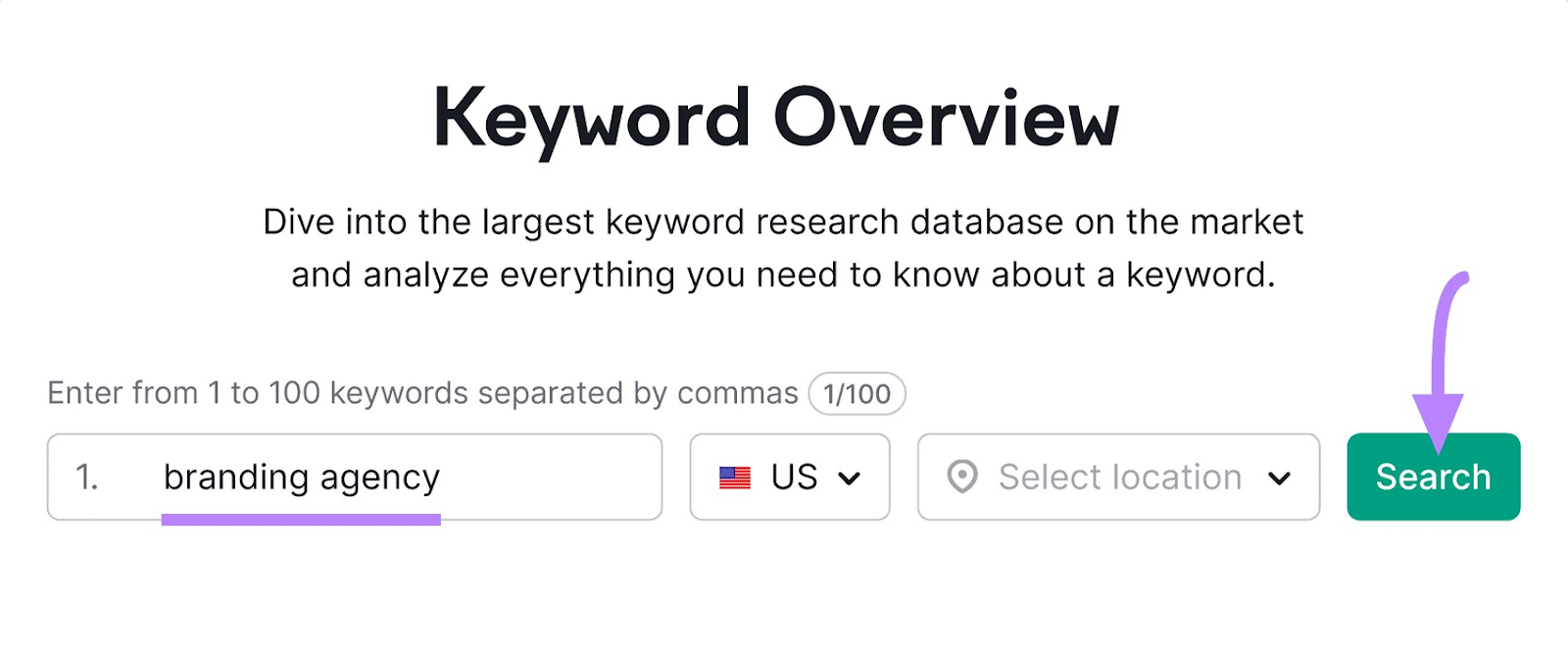
The tool will display a keyword report. Click the “Desktop” setting at the top and change it to “Mobile”:
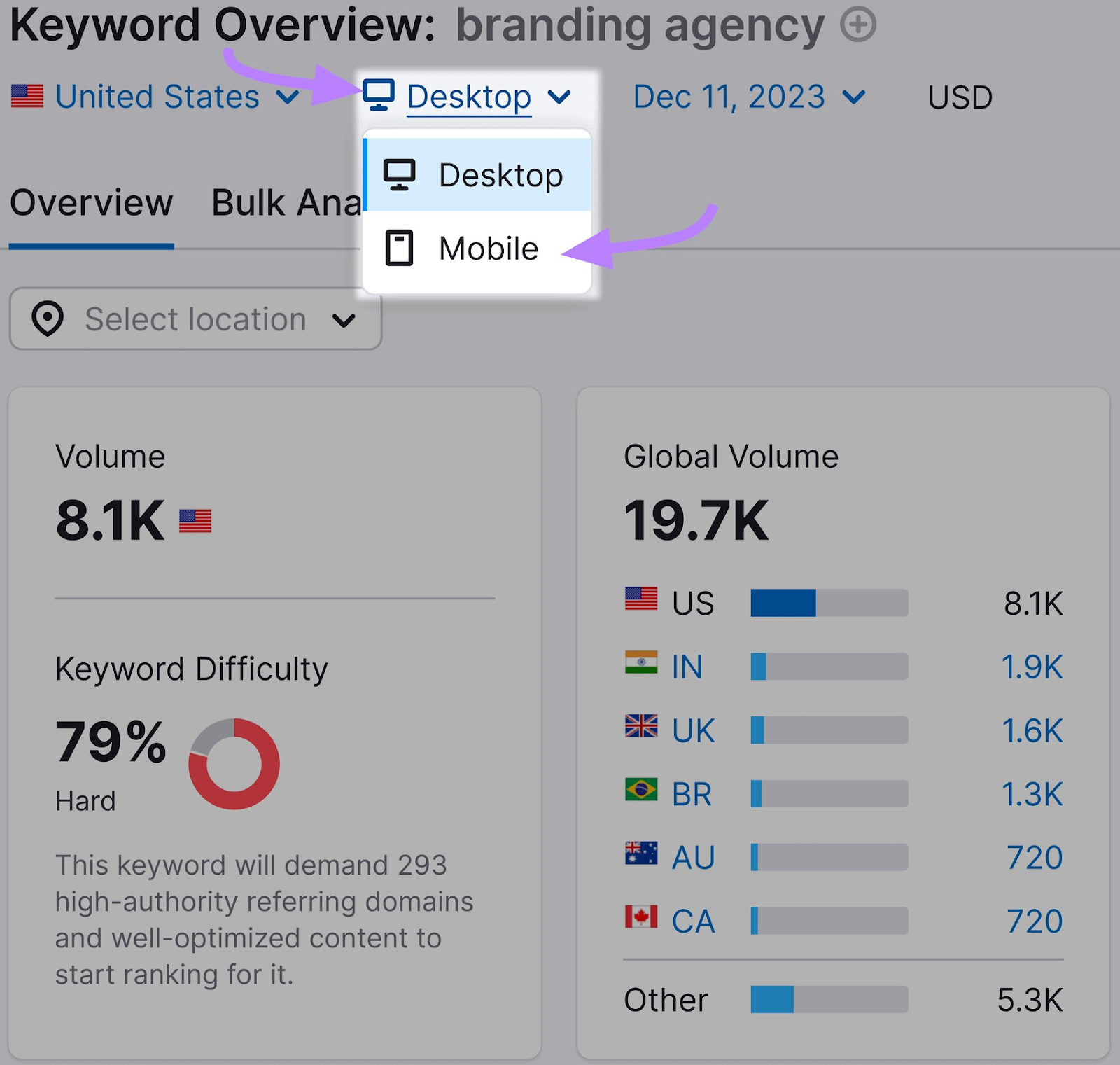
You’ll then get a mobile-specific version of the “Overview” report for your chosen keyword.
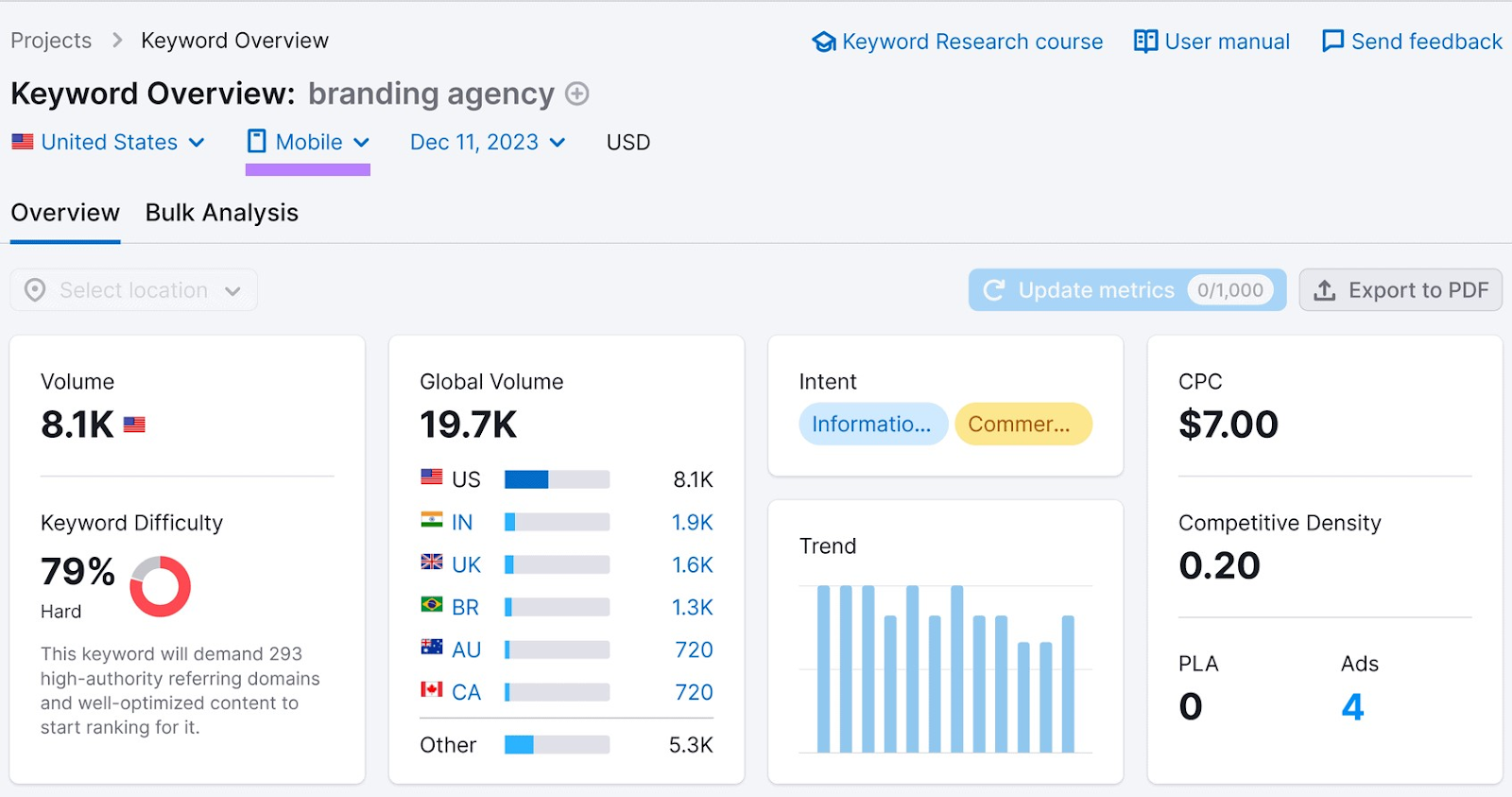
This report will indicate the keyword’s general characteristics. Like its:
- Search volume: A higher-volume keyword could help more people see your ad compared to a lower-volume one
- Search intent (the reason behind a user’s query): A keyword with either the commercial or transactional search intent may be an especially good one for advertising
- Trend: Consider if search demand for the keyword has been trending upward or is cyclical. This will help you determine whether using it is worthwhile.
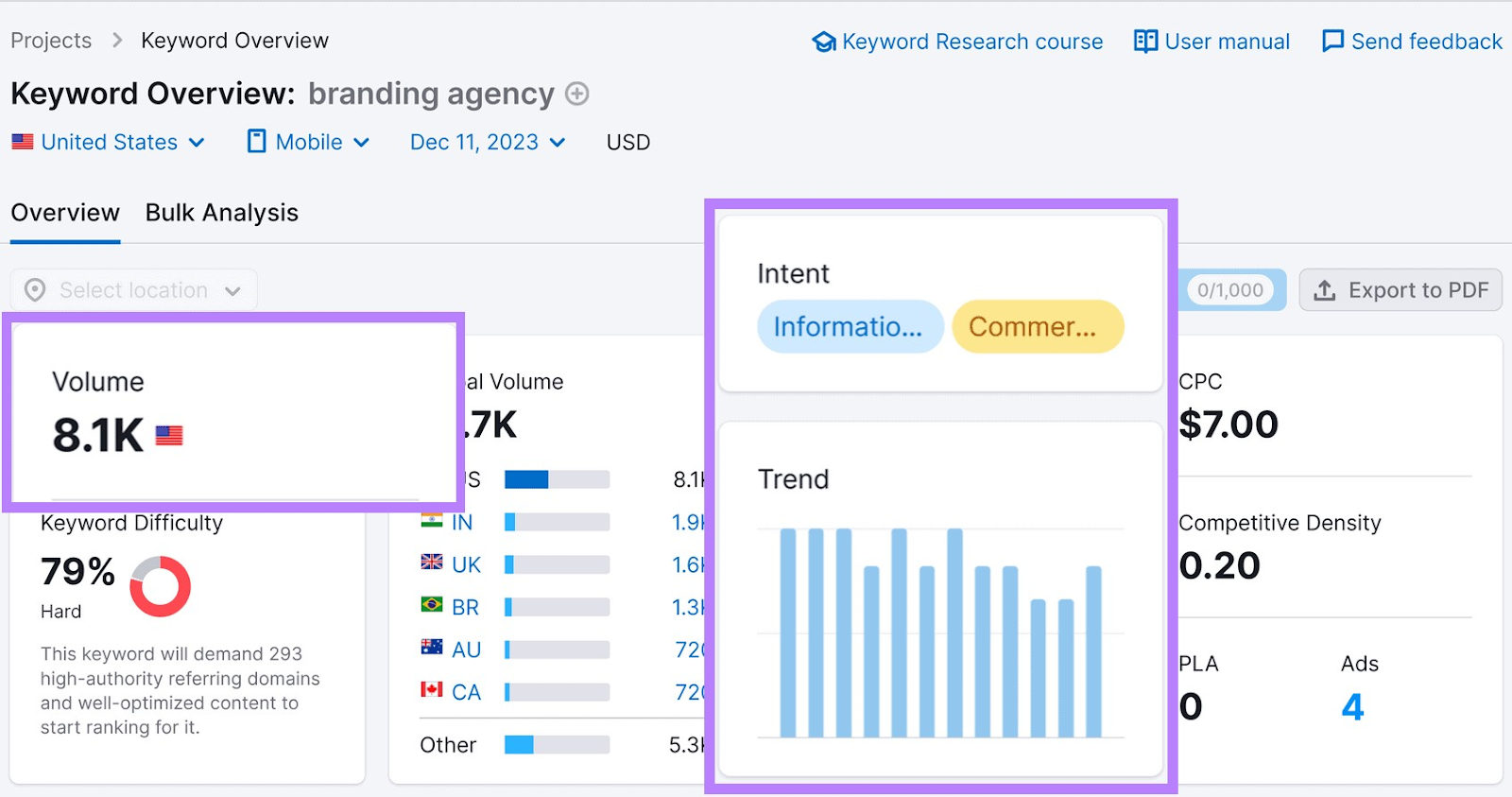
The report will also show ad-specific information like:
- Cost per click (CPC): This is the average amount advertisers are paying for each click on their ads
- Competitive density: A representation of the number of advertisers bidding to place ads on this keyword. The higher the score (with the maximum being 1.00), the more competitive the keyword is among advertisers.
- PLA (product listing ads): The Google Shopping ads that appear for this keyword (if any)
- Ads: The Google search ads that appear for this keyword
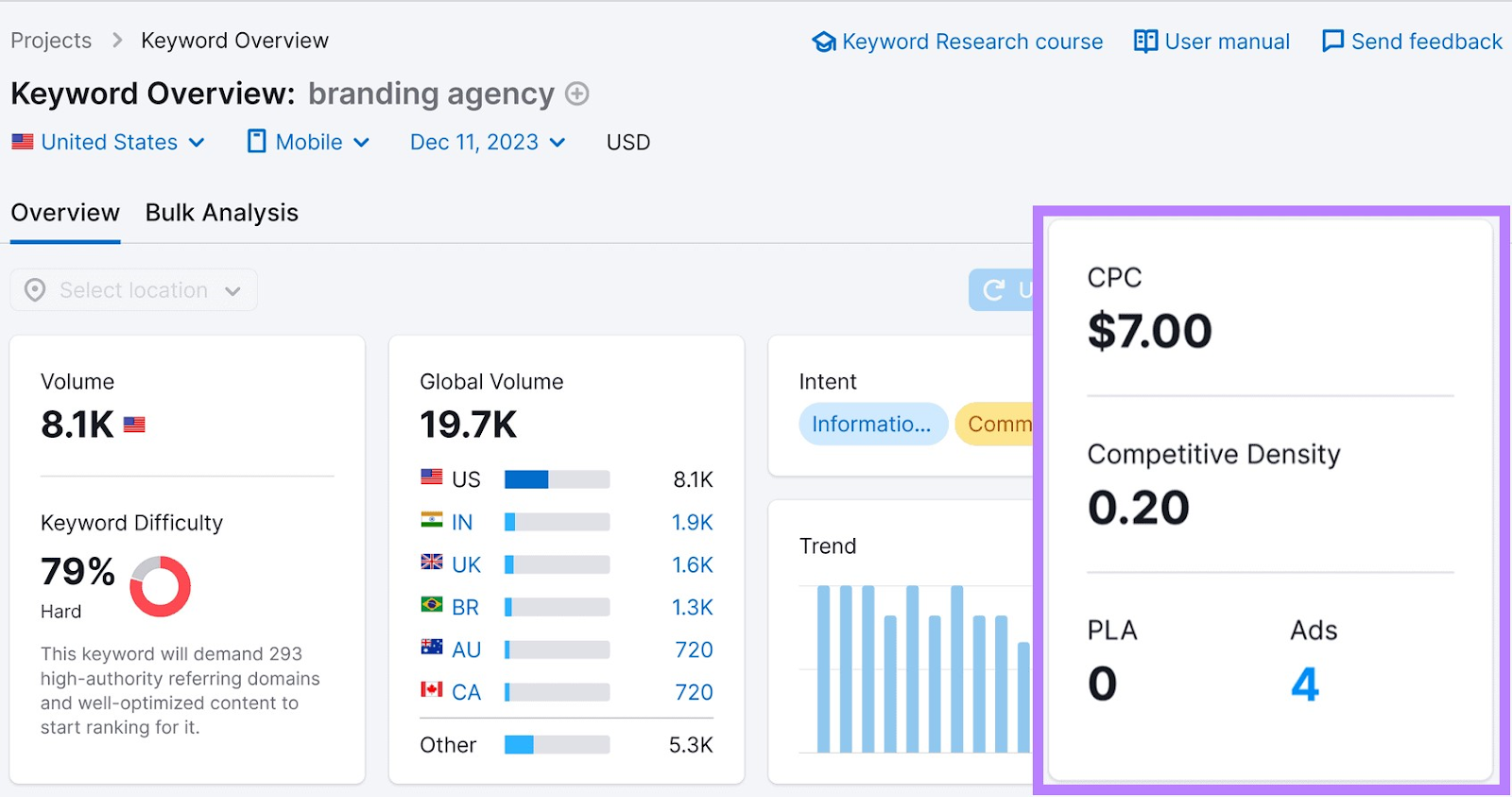
Use all this information to decide whether to include the keyword in your ads. And get an idea of how much your advertising budget may need to be.
Optimize Your Content for Mobile
Mobile-optimizing the landing pages you send users to when they click your ads improves the browsing experience on smaller screens. And makes it easier for users to convert.
For example, here’s a mobile advertisement for ArDrive on the YouTube app:
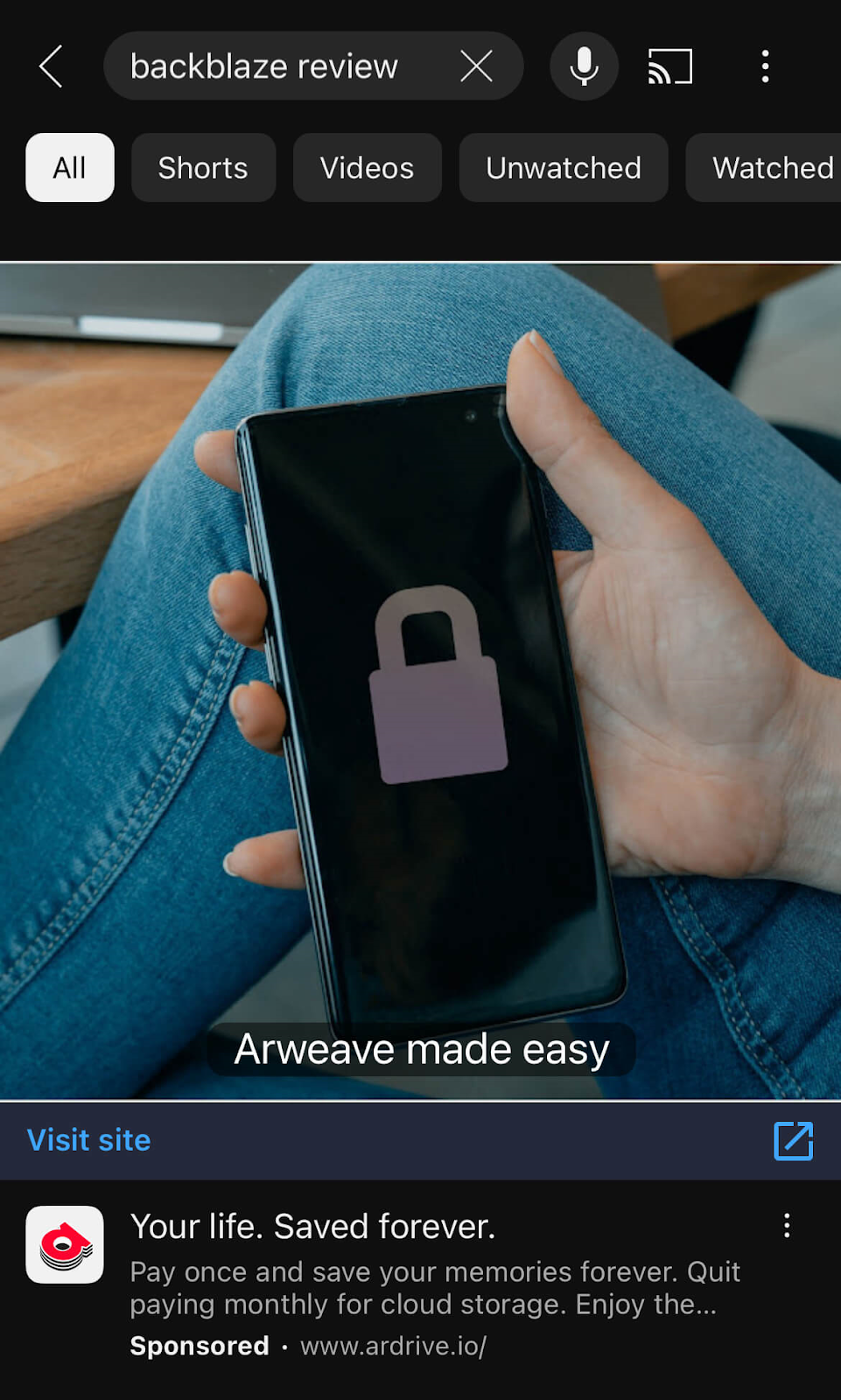
Clicking the ad directs you to ArDrive’s homepage.
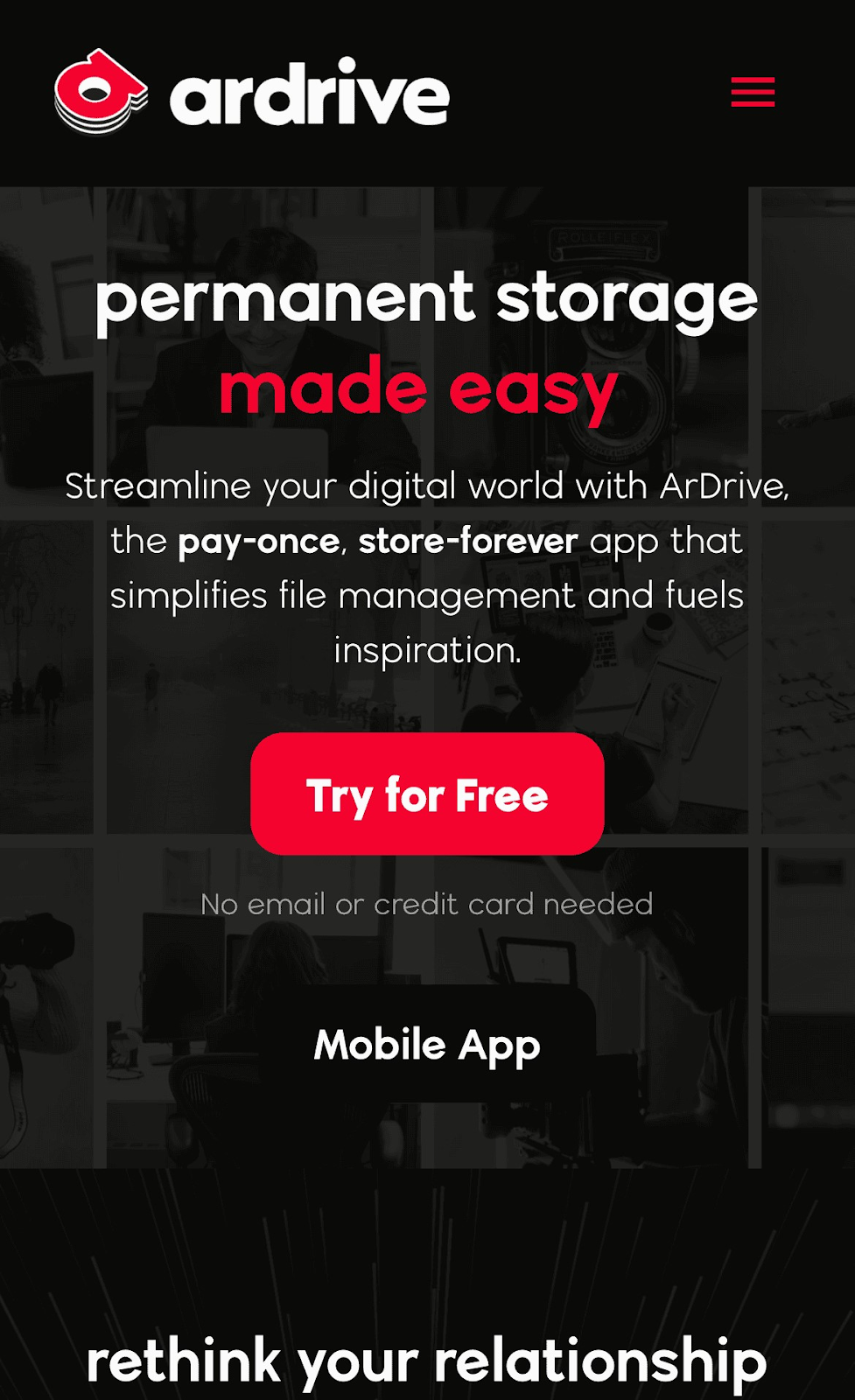
Here’s how the same homepage looks on a desktop computer for comparison.
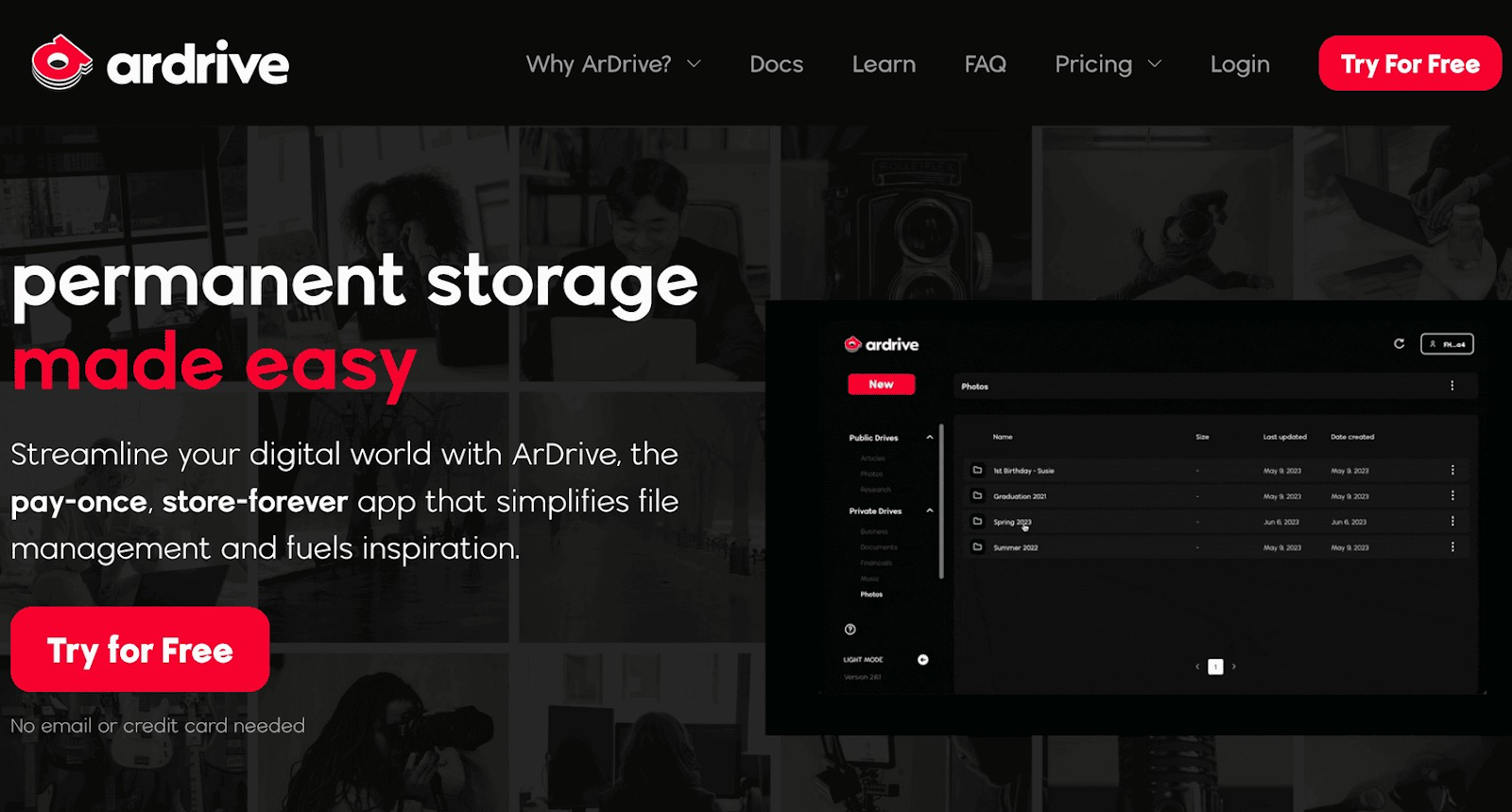
ArDrive has clearly optimized its homepage for mobile by doing things like:
- Moving its “Try for Free” call-to-action button from the left to the middle of the screen. To increase its prominence and help drive more conversions.
- Placing its navigation in a hamburger menu to save on limited screen space and reduce the number of distractions. Which can drive more button clicks.
- Removing an additional image to save space
Target Your Ads Based on Your Audience’s Location
It’s a good idea to show your ads to only users who are geographically close enough to take advantage of your ads’ offers.
Why?
Because it helps you maximize the number of conversions you get for your ad spend. Especially if your products and services are available only in a certain location.
Running different ad campaigns to suit your audience’s location also lets you localize the ad creative and copy to match:
- The language your audience speaks
- The products and services available in their area
- The promotions they’re eligible for
- The currency and units of measurement they use
Here’s a local marketing example courtesy of jeweler Tiffany & Co. The brand displays this mobile ad to Google users in Austin, Texas:
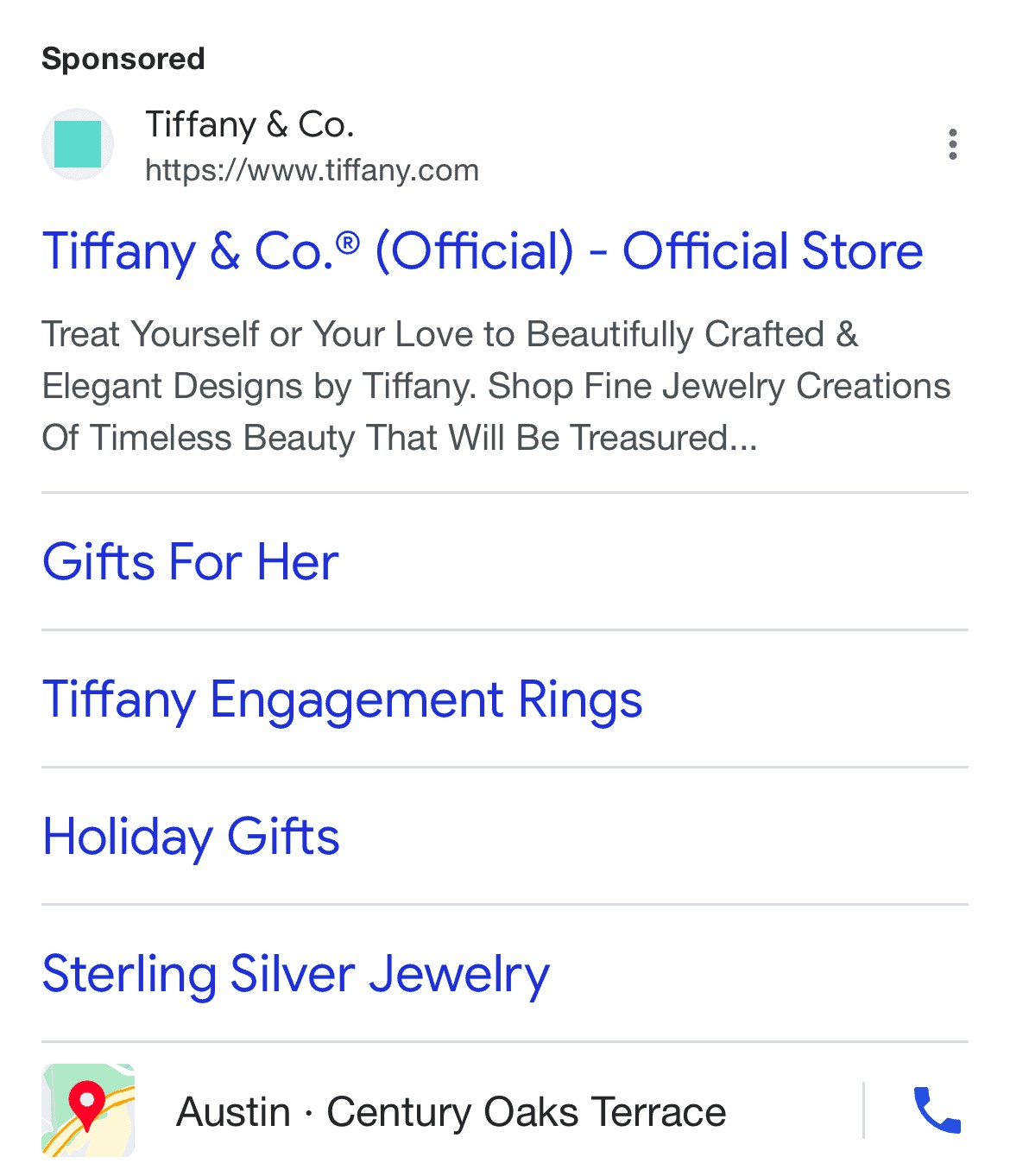
And it displays a different mobile ad for Google users in London.
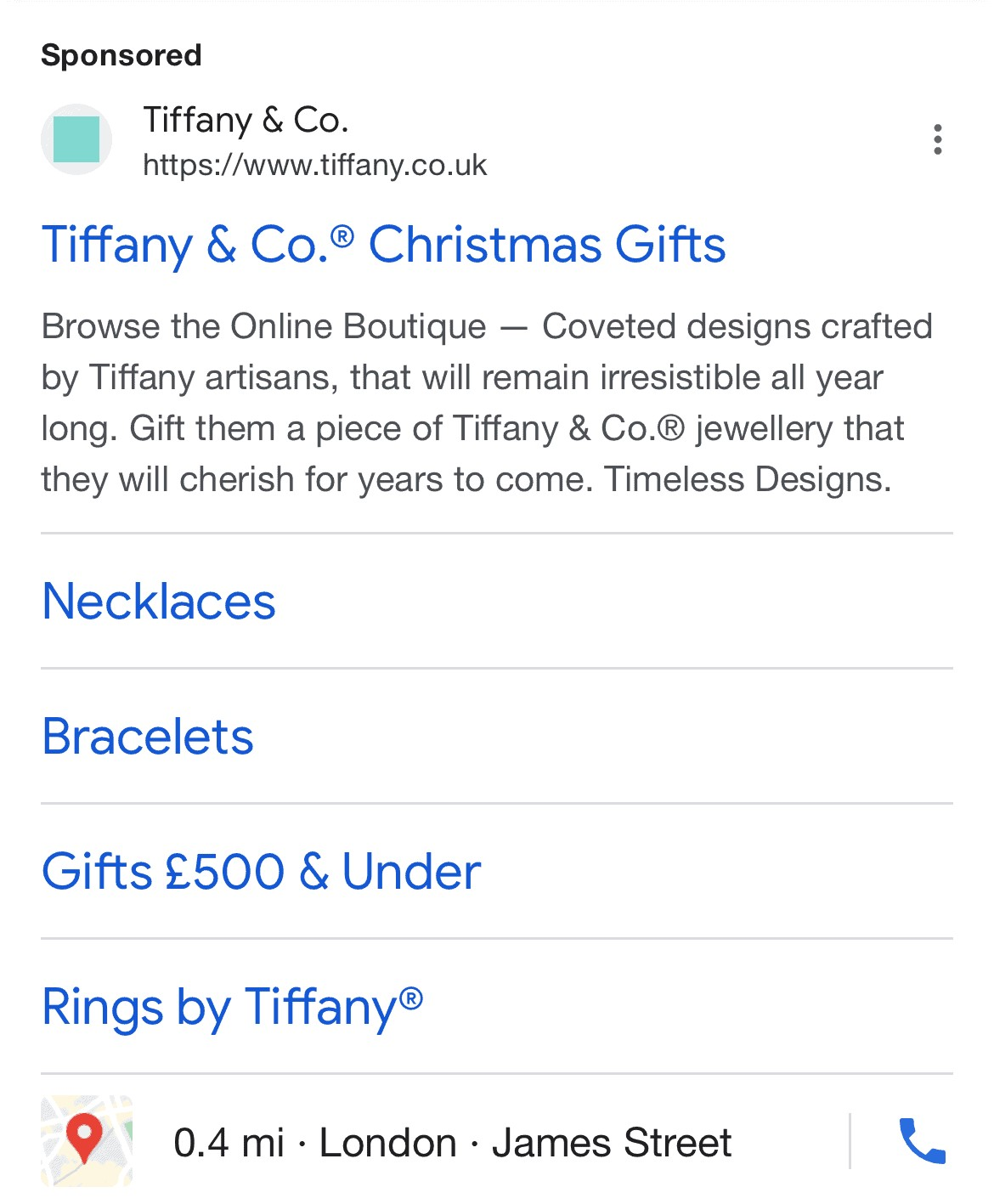
These ads direct users to different store locations. Based on the one the audience is closest to.
There are also some language differences.
The Austin, Texas ad uses American spelling for the word “jewelry.” While its London counterpart spells the same word the British way—“jewellery.”
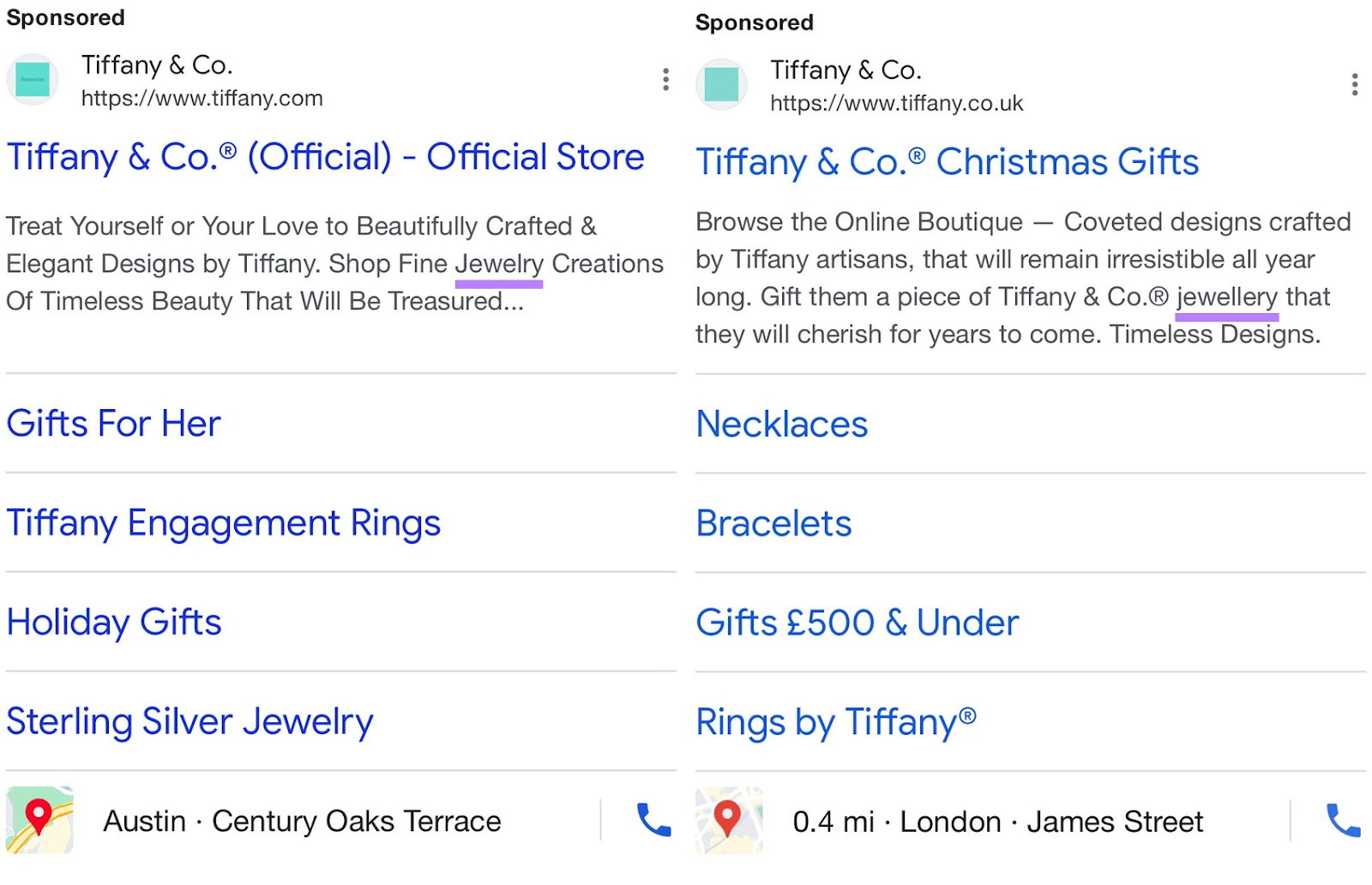
The ads also direct users to the appropriate country-specific website for their location. Being “tiffany.com” for the Austin, Texas audience. And “tiffany.co.uk” for the London audience.
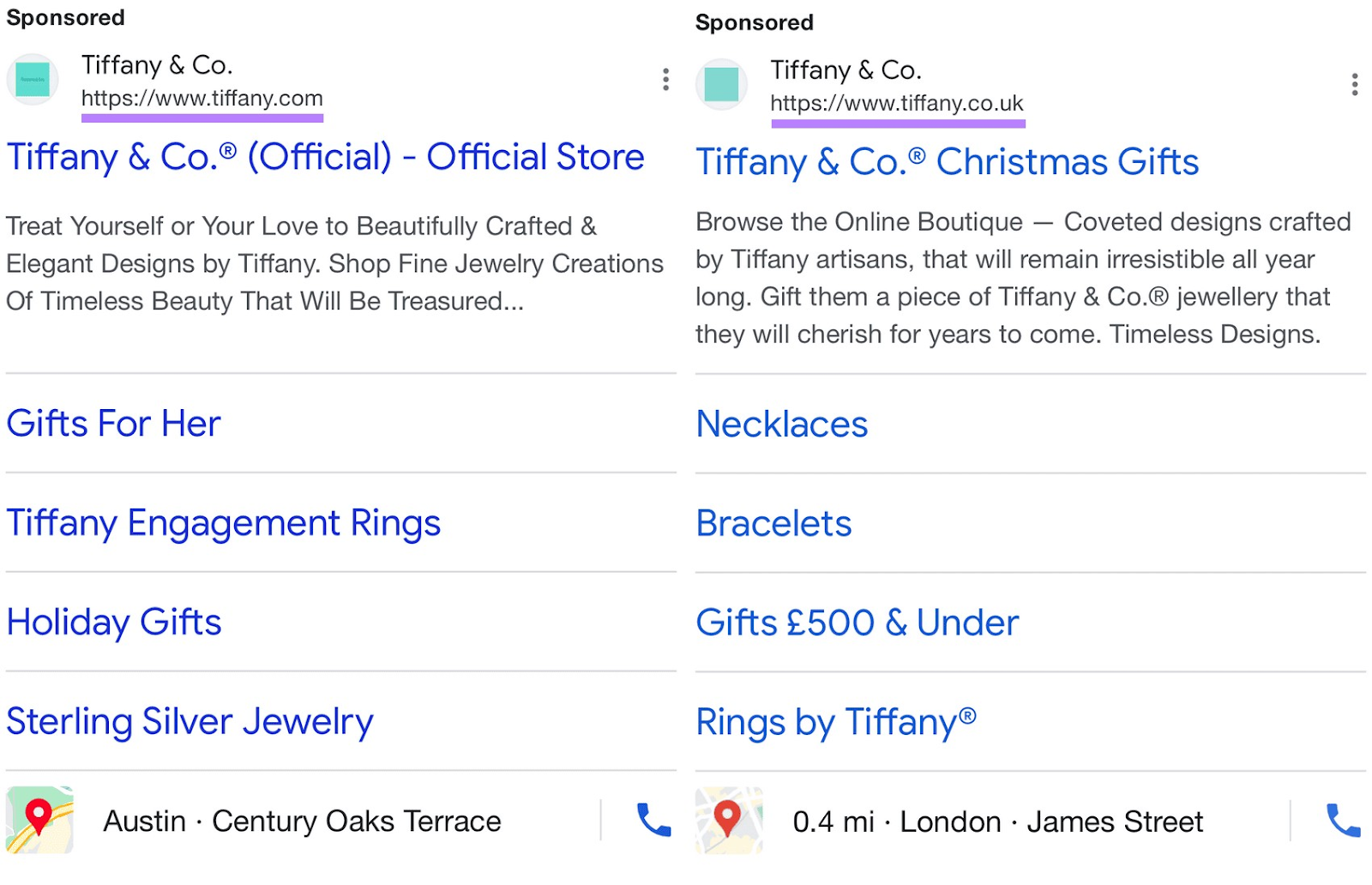
Finally, the London ad displays prices in pounds—the currency used in London.
If you set up your campaign using the Semrush Ads Launch Assistant app, you can choose the preferred devices for displaying your ads.
With Ads Launch Assistant, you can manage Google Ads campaigns from start to finish with AI and Semrush data easily—you'll get the top matching keywords for your campaign, along with auto-generated headlines, ad copy, extensions, and UTM tags.
Further reading: What Is Content Localization? How to Build a Strategy
A/B Test Your Ads
A/B testing is the process of showing your audience two different versions of your ad to see which performs better.
These ads could look highly similar but vary by a single component. Like the ad’s:
- Copy
- Visuals
- Call to action
Here’s an example for testing a different image:
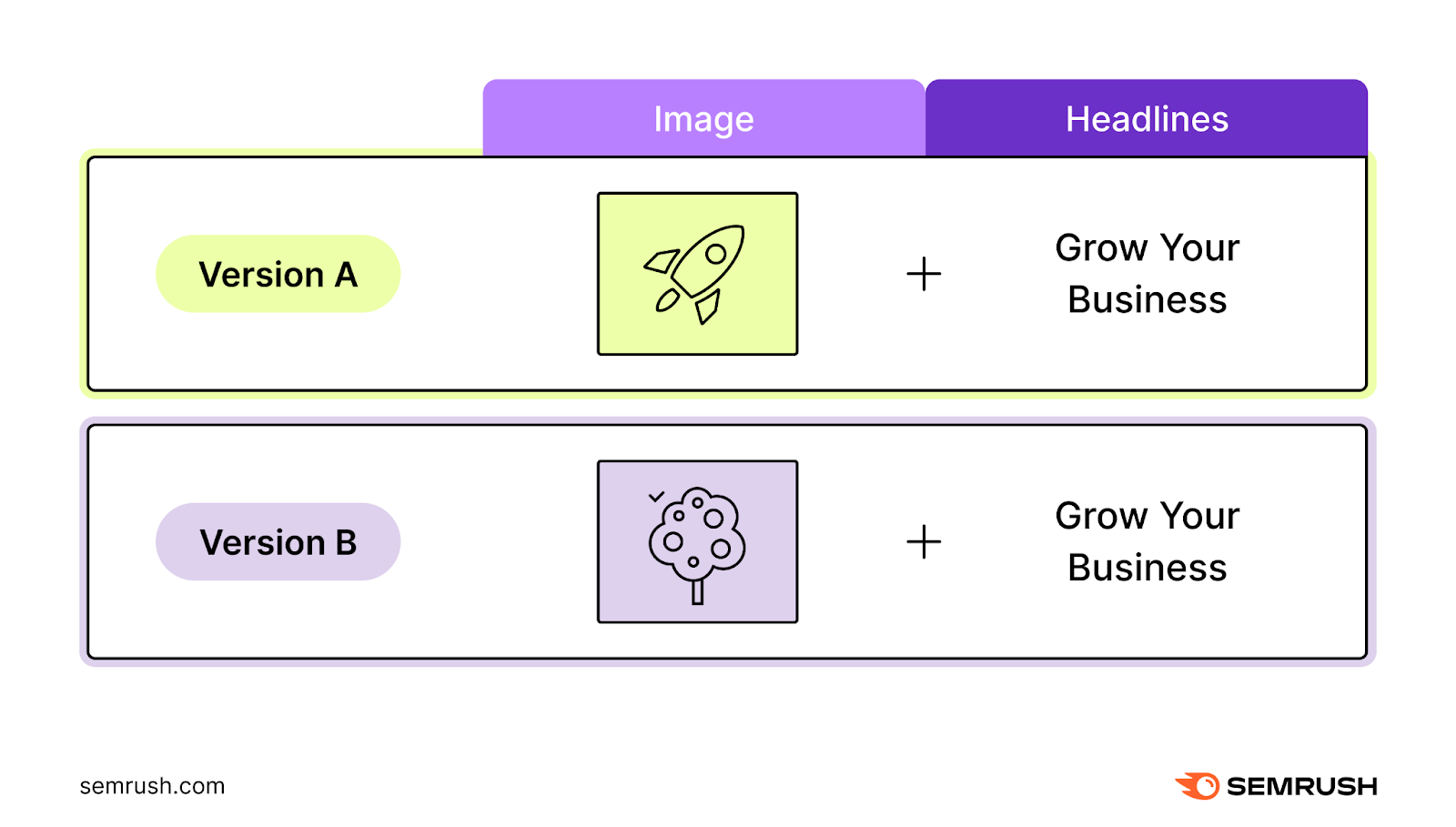
Conducting an A/B test helps you identify which ad version performs best. Which can inform future ad campaigns.
Aim for Mobile Ad Success
Running effective mobile ads involves having a clear understanding of your options and how to ensure they’re optimized for mobile.
One way to ensure your ads are well-suited for mobile is to choose the right keywords.
Semrush’s Keyword Overview can help you identify which search terms to use and gain some additional insights to guide your budgeting.
